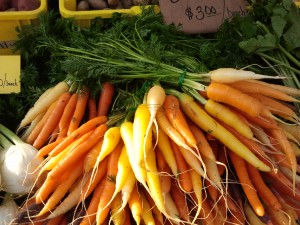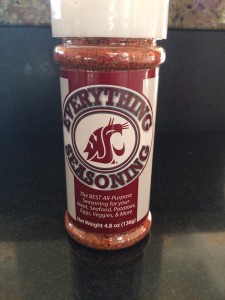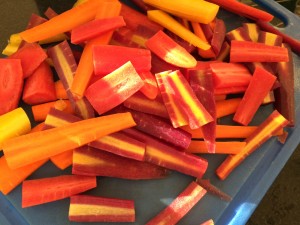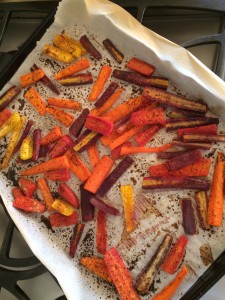Roasted Rainbow Carrots with “Everything Seasoning”
Rumor has it that many people return from “Moms’ Weekend” at Washington State University (WSU) with a hangover.
Not me – but I did return with a bottle.
A sucker for all things “seasoning,” my take-home was Everything Seasoning.
Every table of a popular Pullman restaurant, South Fork, included a bottle of it along with the usual salt and pepper. Curious, I tried a shot on my black bean-lentil burger. I liked it. The next morning I scooped up the three remaining bottles on the WSU bookstore shelves.
My cupboard is full of flavorings such as sumac, zhoug, ras al hanout, shichimi togarashi, fenugreek, a world tour of salts, and peppers ranging from Szechuan, Aleppo and urfa biber to Tasmanian black. But on a post-commute Thursday evening, I reached for the simple Americana flavors of Everything Seasoning and Lemon Pepper.
A bundle of neglected, limp rainbow carrots in my refrigerator’s crisper drawer were the perfect vehicle. Peeled and sliced, the colors came to life and the in-home “aging” concentrated the flavorful sweetness. I’ve seen two celebrity chefs work with deliberately aged vegetables – and I could taste why.
Other-than-orange carrots are not new. People have been eating carrots for thousands of years. According to the World Carrot Museum website, (Reference 2), early carrots were purple or white. Selection and hybridization in the 16th century led to the orange carrot and more recent advances by agricultural researcher have boosted the nutrients in modern carrots to contain 75% more of the antioxidant pigment beta carotene, a precursor to vitamin A (Reference 1).
When you “eat a rainbow” of carrots and other fruits and vegetables you enjoy a bounty of diverse nutrients. Pigments in produce represent an array of phytochemicals, healthy protecting and disease fighting substances.
The colors in rainbow carrots indicate the presence of the following phytochemicals (References 2 and 3 describe details of the potential health benefits of these compounds):
| Orange | beta carotene |
| Black and purple | Anthocyanin pigments, also found in blueberries and other similarly colored produce, are powerful antioxidants in the flavonoid family |
| Red | Lycopene, another form of carotene, is a pigment also found in tomatoes and watermelon |
| Yellow | Xanthophylls and lutein are pigments similar to beta carotene |
| White | lutein |
Carrots can boost dietary fiber intake, too. They are rich in soluble fiber which slows digestion, may help lower blood cholesterol and control blood sugar levels.
How To Roast Rainbow Carrots
- Preheat oven to 425°.
- Cut rainbow carrots crosswise into 3-inch pieces; then cut each lengthwise two or three times, depending on the diameter of the carrots. (Aim for uniformly shaped pieces that will cook in the same amount of time.)
- Arrange on a parchment lined baking sheet and spray or toss with olive oil. Sprinkle with seasonings of choice. I used the WSU Everything Seasoning and Lawry’s Lemon Pepper. You can be more creative, just use something that can withstand the high heat. Consider something to offset the sweetness of the carrots which is concentrated by roasting. Delicate herbs should be sprinkled on after cooking.
- Cover them with another piece of parchment and roast for 12 minutes. This keeps them from drying out. Then remove the cover and roast for 8 to 10 minutes or longer, until they are tender and browned on the edges.
Carrot Roasting Tip
The pros at Cook’s Illustrated recommend covering carrots for the first 15 minutes of roasting in their book, The Science of Good Cooking, page 249. (I did it for 12 minutes.) The process slows the initial cooking and allows for activation of an enzyme in the carrots called pectin methylesterase that stabilizes the pectin by linking to calcium ions in the cell walls. Once uncovered, the temperature of the carrots rises and the enzyme is de-activated but the end result is more moist, yet richly roasted carrots.
Cover your plate with rainbows.
References:
- Eat This Now: Rainbow Carrots by By Alexandra Sifferlin, August 20, 2013. http://healthland.time.com/2013/08/20/eat-this-now-rainbow-carrots/
- World Carrot Museum http://www.carrotmuseum.co.uk/carrotcolours.html
- Colorful Harvest http://www.colorfulharvest.com/Carrots.php
© 2015 Lorelle Del Matto





 About lorelle
About lorelle
[…] about the health benefits of carrots in my blogs Roasted Carrot Soup with Ginger and Dukkah, and Roasted Rainbow Carrots. Try my other go-to herb sauces Italian Salsa Verde, Thai Cilantro Sauce, Chimichurri with fresh […]